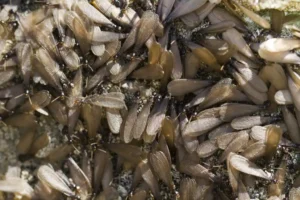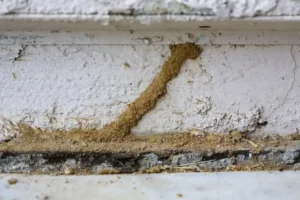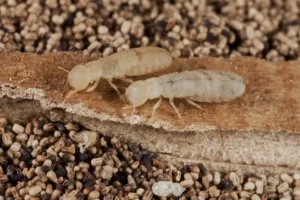Termites cause an immense amount of damage to homes and businesses across the world. Their colonies will eat 24 hours a day, seven days a week all year long. So it is important to keep a watch for possible termites in and around your home. Luckily termites do not do immediate damage that is irreversible.
It is, however, when termites are ignored or not found and allowed to eat freely that they do their most damage.
But how do you know if you have termites? Here’s our handy checklist of items to be aware of and look for so that you know what termites look like.
Colonies: One does not come across a termite colony in the same manner as an ant colony. Termite colonies will remain underground and only emerge to the surface to find a food source or to swarm and create new colonies. If you have a colony of termites on your property you likely will see termites regularly. Colonies will expand so even if you have not seen them in recent years it is good to keep vigil. Termite colonies tend to invade areas that are not occupied by other colonies. This is why an old adage goes around that “It’s not if you will get termites, but when.”

Swarmers: If you go for a walk around the house then you may notice some masses of flying insects that were not there the day before. Termite colonies will create swarms of termites to mate and create newer termite colonies. Termites will sprout equidistance wings and start to fly around in the hundreds (feels like the thousands). Swarmers are generally not dangerous at this point. If they do not find a mate to create a new colony with then they will die off in a short period of time. The appearance of a swarm though does indicate the presence of an established colony and will need quick attention.
 Mud Tunnels: Subterranean termites, as mentioned before, will remain underground and emerge to find food sources. Termites need the ability to move without drying out and being exposed to predators so they will create mud tunnels that allow them to move from the ground towards & through a food source. Tunnels will often be found in moist & cool areas of ground. Crawl spaces, shaded areas of a home’s foundation, and wood piles are popular spots where termites surface and start feeding. Tunnels in the earliest of stages can be difficult to spot because of their size, so it is important to look carefully around the house for mud tunnels.
Mud Tunnels: Subterranean termites, as mentioned before, will remain underground and emerge to find food sources. Termites need the ability to move without drying out and being exposed to predators so they will create mud tunnels that allow them to move from the ground towards & through a food source. Tunnels will often be found in moist & cool areas of ground. Crawl spaces, shaded areas of a home’s foundation, and wood piles are popular spots where termites surface and start feeding. Tunnels in the earliest of stages can be difficult to spot because of their size, so it is important to look carefully around the house for mud tunnels.
Termite Cement: Termite cement is the next stage of mud tunnels. Termite mud will harden in cracks and other areas they are feeding in order to seal off predators and seal in moisture. Where the tunnels are long and thin and lead to a specific point, the cement would cover a wider area of a food source.
Damaged Wood: Termites will eat just about anything with cellulose, so any wood based product is game for being eaten by termites. Every year there are some fantastic stories of termites eating someone’s fortune by actually eating away at their money. If you go looking around in those moist areas of the home and find some termite tunnels or cement, then it is probable that you will find damaged wood. Damaged wood is also one of the signs that can often be misdiagnosed. Water damaged wood will be more broken apart in chunks breaking at lines of the wood rings. Termite damaged wood will have mud evidence as well as a very erratic destruction pattern. Carpenter ants will eat into wood, as well as termites, but you will leave a dry sawdust versus the moist mud.

Active Termites: Last but not least you may find termites themselves. Termites are small white/cream insects to an orange brown color. They are, generally, slightly larger than a common ant. There are different types of termites in a colony, you would likely spot a worker or soldier termite. The soldier termite often has a claw at its head and is designed to protect the colony. The workers take care of the soldiers and the queen of the colony.